The Electronic Intifada 7 April 2025
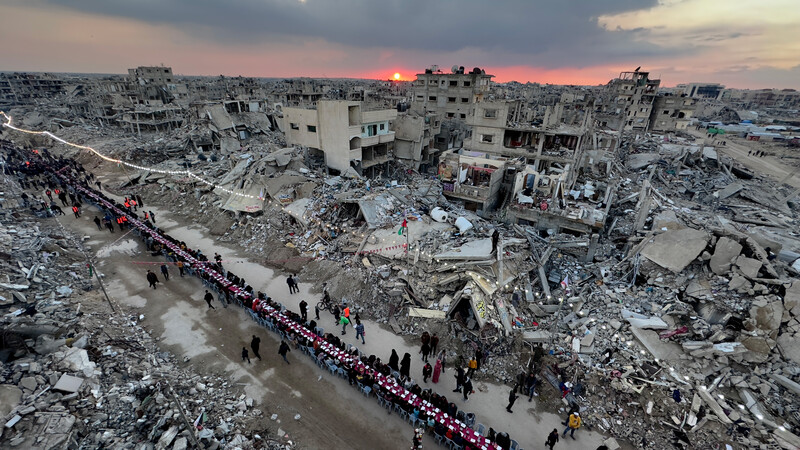
People sit for the first Iftar (breaking of the fast) of Ramadan in Rafah, southern Gaza, on 1 March.
ActiveStillsDuring the month of March, Israel blew up the ceasefire in the occupied Gaza Strip and killed more than 1,000 people there while denying the entry of humanitarian aid, plunging the surviving population into the worst crisis yet.
Israel meanwhile pressed on with its military assault on refugee camps in the north of the occupied West Bank that began in late January.
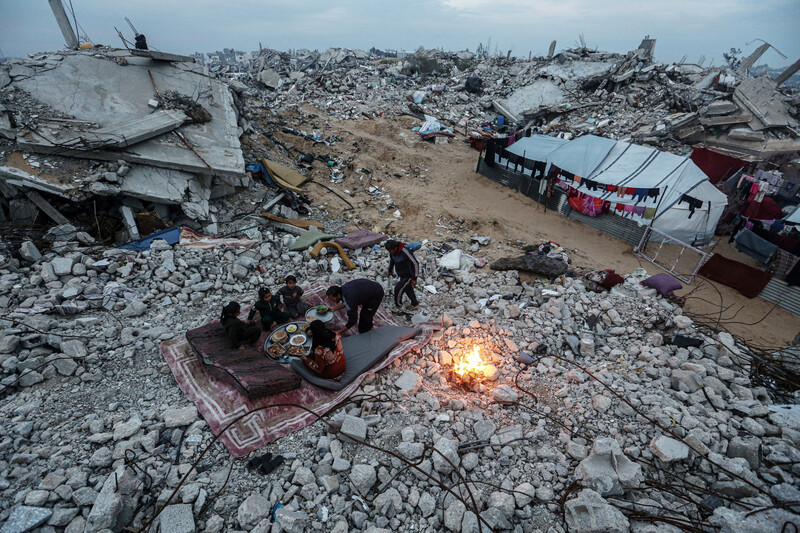
Karam Abu Haloub, his wife Faten and their family prepare for iftar during the third day of Ramadan near a tent they set up on the ruins of their destroyed home in the al-Shimaa area of Beit Lahiya, northern Gaza, 3 March.
APA imagesDozens of Palestinians have been killed during the ongoing operation in the West Bank. The Israeli military has also displaced tens of thousands of people from their homes – the largest forcible displacement event in the territory since 1967.
In the northern West Bank city of Jenin, the Israeli military has “ravaged and besieged residential neighborhoods, the destruction resembling that in Gaza,” The Electronic Intifada reported during March.
Total siege
Benjamin Netanyahu, Israel’s prime minister, announced the imposition of a total siege on Gaza on 2 March, hours after the expiration of the first phase of the ceasefire and prisoner exchange agreement that came into effect nearly two months earlier.
Gaza has been under total closure ever since, with Israel denying the entry of fuel, humanitarian aid and commercial goods in the longest such suspension of life essentials in the territory since the beginning of the genocidal war in October 2023.

Israeli forces blow up the home of Ahmad al-Haymouni in the West Bank city of Hebron on 5 March. Al-Haymouni, together with Muhammad Misk, carried out a shooting and stabbing attack in Jaffa in October in which seven Israelis were killed and several others injured. Misk’s home was destroyed the same day in an act of collective punishment prohibited under international law.
ActiveStillsBezalel Smotrich, Israel’s far-right finance minister, said that the Israeli government decided “to completely halt humanitarian aid to Gaza until Hamas is destroyed or completely surrenders and all our hostages are returned.”
He said that the “gates of hell” must be opened “as quickly and lethally as possible on the cruel enemy, until absolute victory.”
Days before Netanyahu’s announcement, COGAT, the Israeli military unit that administers the occupation, revealed a plan to establish “humanitarian hubs” in Gaza.
Under the scheme, “COGAT will dictate the distribution of urgently needed humanitarian aid to ‘vetted Palestinians’ only” in areas under full Israeli military control, according to Palestinian human rights groups.
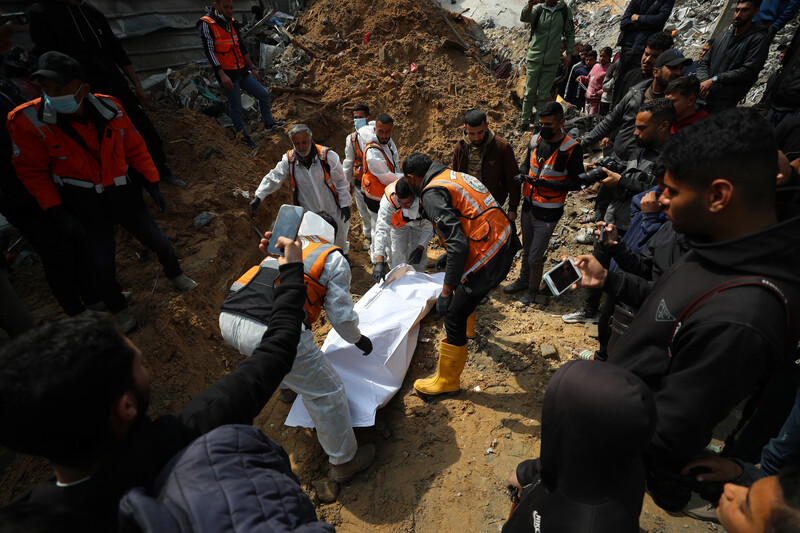
The bodies of 30 Palestinians who lost their lives during Israeli army raids and were buried in a mass grave are exhumed for identification and proper burial in the al-Alemi district of Beit Lahiya, northern Gaza, 5 March.
APA imagesOnly the Karem Abu Salem crossing would be used for the entry of humanitarian aid under the scheme and only nongovernmental organizations registered in Israel would be allowed to operate in Gaza. This would effectively bar UNRWA, the UN agency for Palestine refugees – which is both the biggest relief operation in Gaza and currently outlawed by Israel.
Palestinian human rights groups warned that the COGAT plan presented to the UN and international aid organizations “is a concerning development in its ongoing genocide and represents a clear advancement of its annexation of Palestinian territory.”
“Weaponizing aid”
The total blockade has left people in Gaza unable to meet their basic needs.
“Essential goods have vanished from the market, prices have soared and most bakeries have been forced to close due to the lack of flour and fuel needed to operate generators,” Al Mezan, a human rights group, stated on 2 April.
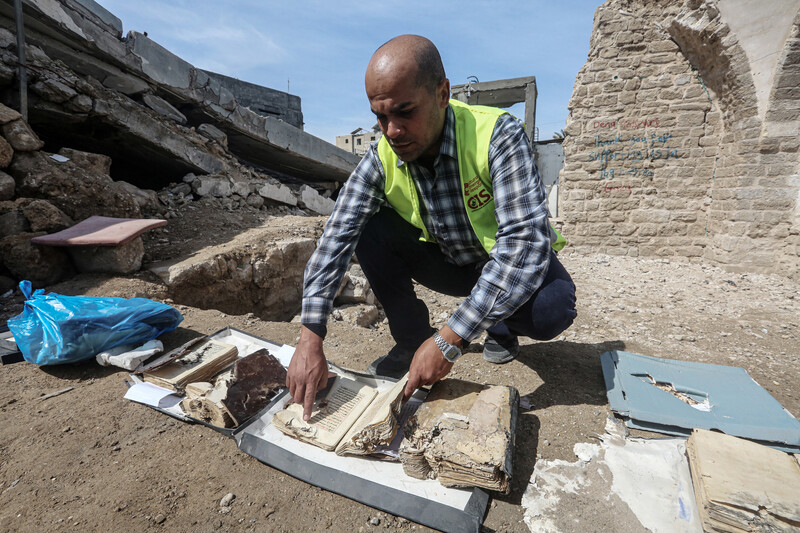
An official with the Department of Manuscripts and Antiquities, affiliated with the Palestinian Ministry of Endowments and Religious Affairs in the Gaza Strip, attempts to recover what remains after the Israeli military targeted the library of the Great Omari Mosque in Gaza City, 6 March.
APA images“Israel’s continued closure of crossings and the obstruction of humanitarian aid are worsening the situation in Gaza to an unprecedented degree – even compared to the past 17 months,” said Samir Zaqout, Al Mezan’s deputy director.
“Without fuel, essential services such as desalination plants and water wells have ceased functioning, pushing people toward life-threatening levels of thirst and hunger,” Zaqout added.
On 6 March, more than two dozen UN human rights experts stated that “by deliberately cutting vital supplies, including those relating to sexual and reproductive health, and assistive devices for persons with disabilities, Israel is once again weaponizing aid.”
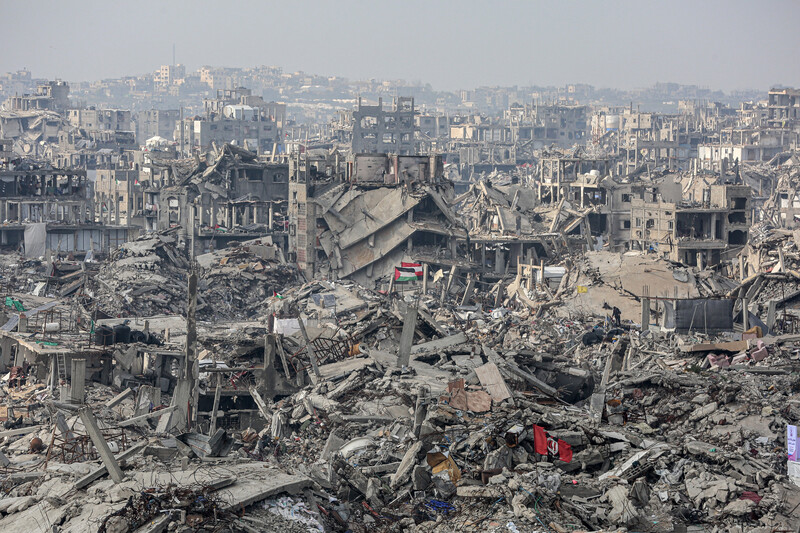
A general view of the destruction in Jabaliya, northern Gaza, on 8 March.
APA imagesThe UN experts added that during the ceasefire, “conditions remained very harsh. Very few tents and no mobile units were allowed into Gaza, and Palestinians, including children and older persons, continued to die due to the cold and dire conditions.”
“Reinstating a total-siege policy against a population that has barely survived 16 months of constant bombardment, repeated forced displacement and 80 percent of farmland and civilian infrastructure destroyed, will aggravate the dire situation,” the experts said.
Annexation “advancing at full speed”
Meanwhile, in the West Bank, the experts said that “the annexation of territory by force is advancing at full speed.”
They added that “refugee camps and cities are being bombed, depopulated and looted, and other areas are attacked by armed settlers with complicity of Israeli forces.”

Displaced people queue to receive food from a charity kitchen before iftar in Jabaliya, northern Gaza, 11 March.
APA imagesOn 12 March, according to the UN monitoring group OCHA, “an 18-year-old Israeli settler was shot and injured while driving near Ariel settlement” near Salfit in the West Bank. Following the shooting, Israeli settlers attacked residents of a Bedouin community, injuring two people, including an elderly man who sustained a brain hemorrhage and was in critical condition.
The following day, dozens of settlers set fire to homes in a Bedouin community near Nablus, a city in the northern West Bank. According to OCHA, the settlers “threw a Molotov cocktail, setting a room on fire while a baby and a toddler were inside.”
The settlers took the children from the house and left them outside around 50 meters away from the home.
A few days later, an 18-year-old Palestinian lost consciousness after he was attacked by settlers while grazing sheep near Hebron in the southern West Bank.
Israel’s strategy “to dominate and destroy”
On 12 March, the Euro-Med Human Rights Monitor stated that Israel had killed 150 Palestinians in Gaza since a ceasefire went into effect on 19 January.
“The ongoing killings by the Israeli army are carried out by snipers and drones, including quadcopter aircraft,” the rights group said.
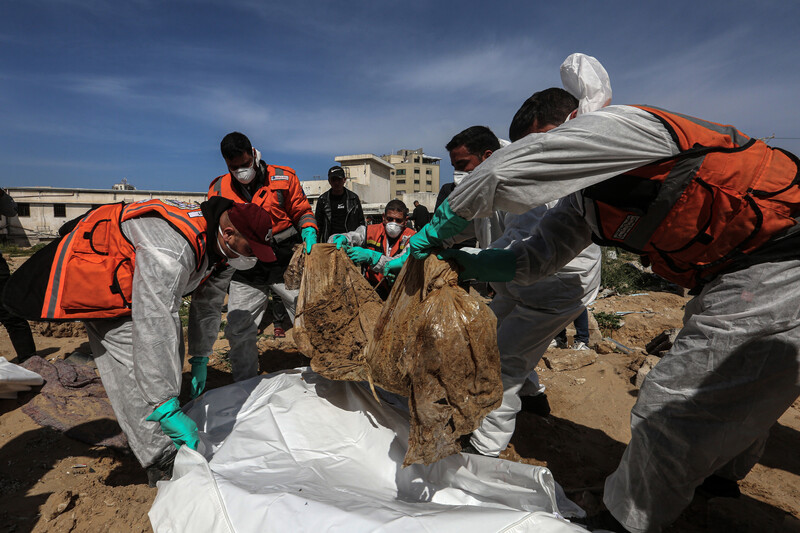
The bodies of Palestinians killed during Israeli raids and buried in a mass grave at Al-Shifa Hospital are exhumed for identification and proper burial, Gaza City, 13 March.
APA images“The deadly attacks frequently occur when residents attempt to return and inspect their damaged homes near the so-called ‘buffer zone’ imposed by Israel along the Strip’s northern and eastern borders,” Euro-Med added.
On 13 March, an independent UN commission of inquiry issued a report finding that since October 2023, “Israel has increasingly employed sexual, reproductive and other forms of gender-based violence against Palestinians.”
According to the investigators, Israel is perpetrating sexual and gender-based violence across the West Bank and Gaza Strip “as a strategy of war for Israel to dominate and destroy the Palestinian people.”
Israel massacres families, blows up ceasefire
In the early hours of 18 March, Israel launched intensive attacks by air, land and sea across Gaza, killing at least 400 people and injuring more than 560, the health ministry in the territory said later in the day.
Entire families were massacred in the strikes, according to the government media office in Gaza, and at least 174 children were among the dead, according to Defense for Children International-Palestine. Ayed Abu Eqtaish, a program director with the children’s rights group, said that it marked “one of the largest one-day child death tolls in Gaza in history.”

A view of the Dome of the Rock, in Jerusalem’s al-Aqsa mosque compound, during the second Friday of Ramadan, 14 March. Due to Israeli movement restrictions, the al-Aqsa mosque — one of the holiest sites in Islam — is inaccessible to the vast majority of Palestinians, including those in Gaza.
ActiveStillsThat same day, the Israeli military ordered the evacuation of areas near Jabaliya in the north and Khan Younis in the south while launching attacks across Gaza and effectively announcing Israel’s withdrawal from the negotiations process to permanently end the war in Gaza.
“From now on, Israel will act against Hamas with increasing military strength,” Netanyahu said at the outset of the resumption of the full-scale genocidal war.
Several government officials in Gaza were killed along with members of their families in the Israeli strikes.
Hamas spokesperson Sami Abu Zuhri accused Israel of attempting to impose a surrender agreement on the Palestinian people. He alleged, too, that Washington and Tel Aviv were attempting to change the terms of the ceasefire agreement that Israel had signed and the US had guaranteed.
That agreement included a path to end the war once and for all and to assure the flow of humanitarian aid into Gaza.
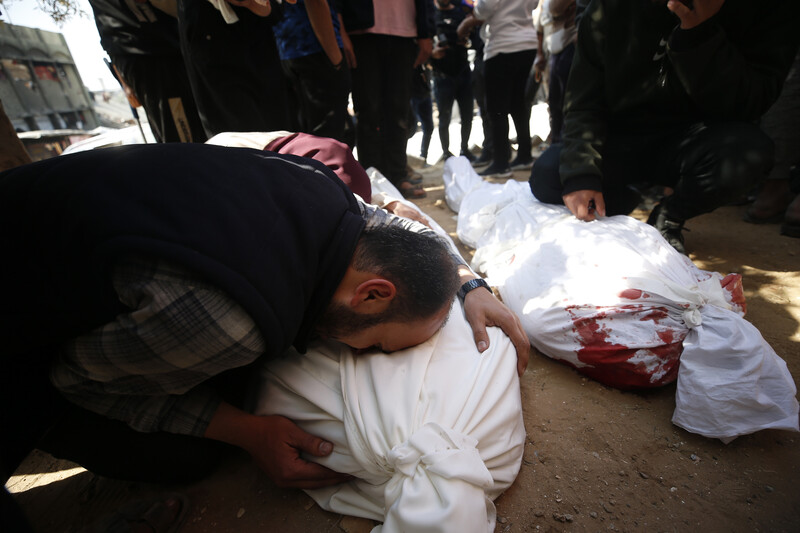
Relatives of nine Palestinians, including three journalists, killed in an Israeli attack in Beit Lahiya, mourn at the Indonesian Hospital on 15 March. According to sources, an Israeli drone hit a relief team distributing tents to residents whose homes had been destroyed.
APA imagesOn 19 March, a Bulgarian national working for the UN was killed in a strike on a guesthouse for the UN Office for Project Services in Deir al-Balah, central Gaza.
That same day, Israel Katz, the Israeli defense minister, issued “a final warning” to the population of Gaza in an apparent declaration of genocidal intent.
“Things will become much more difficult, and you will pay the full price,” Katz said, adding that “evacuation of the population from combat zones will soon resume.”
“Take the US president’s advice. Return the hostages and remove Hamas, and other options will open up for you, including relocation to other places in the world for those who choose,” Katz added.
“The alternative is total destruction and total devastation.”
Child dies in Israeli detention, emergency workers “executed”
On 22 March, Walid Khalid Abdullah Ahmad, 17, died after collapsing in the yard of Megiddo prison in northern Israel, where the boy had been held in pre-trial detention since September last year.
“Walid is the first Palestinian child to ever die inside Israeli prisons,” according to Defense for Children International-Palestine, which added that “Israeli authorities are withholding his body from his family.”

Palestinians break their Ramadan fast amid the destruction and debris during a mass iftar in Beit Lahiya, northern Gaza, on 15 March.
APA imagesAn autopsy report indicated that the boy, who was detained at his home in the West Bank town of Silwad in September, was starved and beaten by prison guards for months before he collapsed and and died.
Earlier in the month, Palestinian authorities announced the death of a man from Jenin refugee camp in Israeli custody. The man had been held without charge or trial before reportedly dying in unclear circumstances on 23 February.
At least 63 Palestinians have died in Israeli detention since 7 October 2023, including 40 detainees from the Gaza Strip, according to the Palestinian Prisoners Club.
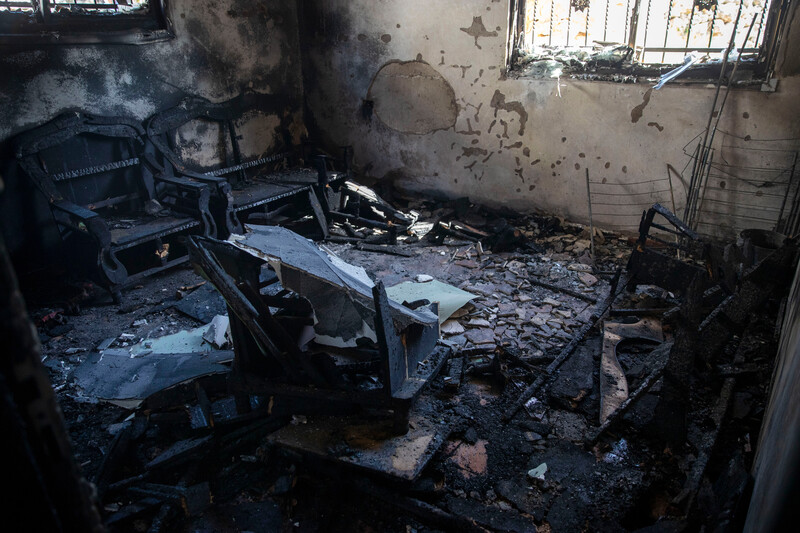
The interior of a home belonging to a Palestinian family in the West Bank village of Khirbet al-Marajim on 15 March after around 50 Israeli settlers stormed the village the previous night. The settlers threw stones at residents and set fire to three homes and a car while families were sleeping inside. In one of the rooms, two children were asleep when settlers abducted them and later released them in a different location.
ActiveStillsOn 23 March, a Palestine Red Crescent Society ambulance crew was dispatched to evacuate people who were injured in an Israeli airstrike in the al-Hashashin district of Rafah, southern Gaza, before the medics also came under fire and sustained injuries.
Additional ambulance crews and civil defense rescue workers had been sent to the scene when Israeli forces surrounded the area and communication with the emergency personnel was lost.
The fates of the 15 emergency workers were unknown until a week later, when civil defense teams were able to access the site and recovered a body in late March. Fourteen more bodies were found in a mass grave over the next few days.
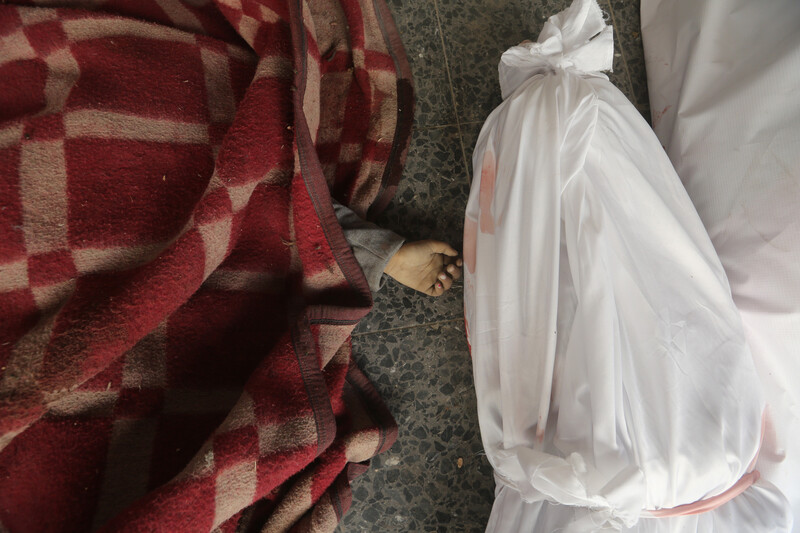
The bodies of people killed in an Israeli airstrike in central Gaza are seen the morgue of Al-Ahli Arab Hospital in Gaza City on 18 March.
APA imagesDr. Ahmed al-Farra, a senior doctor at Nasser Medical Complex, told The Guardian that the bodies of the medics and civil defense workers “had bullets in their chest and head. They were executed. They had their hands tied.”
One of the paramedics was on a call with a Palestine Red Crescent Society ambulance dispatcher at the time of the attack. Dr. Bashar Murad, a Red Crescent director in Gaza, was quoted by The Guardian saying that on that call, “gunshots fired at close range could be heard as well as the voices of Israeli soldiers on the scene speaking in Hebrew, ordering the detention of at least some of the paramedics.”
The dead included eight Red Crescent medics, six civil defense workers and an employee of UNRWA, the UN agency for Palestine refugees.
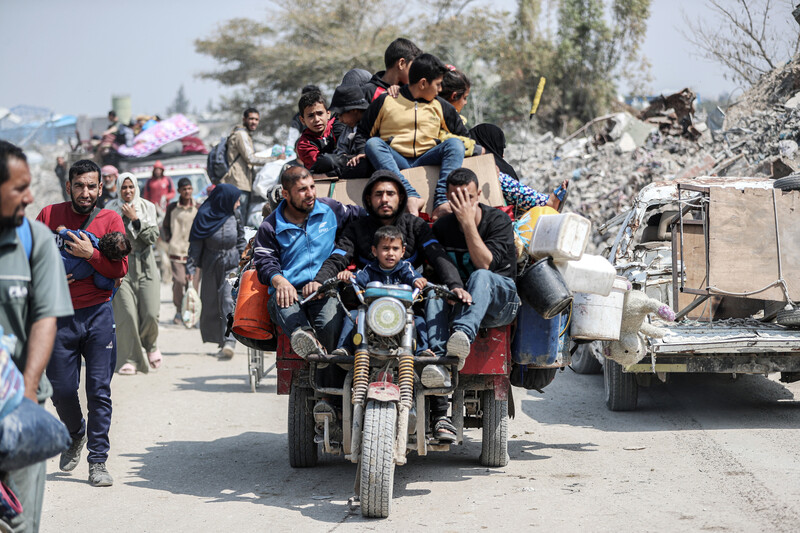
Families flee after the Israeli army issued evacuation orders for several neighborhoods in Beit Hanoun, northern Gaza, following heavy airstrikes on 18 March.
APA images“They were killed by Israeli forces while trying to save lives,” Tom Fletcher, the UN humanitarian chief, said on 31 March. “We demand answers and justice.”
Israel has killed more than 100 civil defense workers,1,000 health care workers and 280 UNRWA employees since October 2023.
Israel blows up cancer hospital
On 21 March, the Palestine Red Crescent Society reopened Al-Quds Hospital in Gaza City’s Tal al-Hawa neighborhood. The facility was forced to shut down in November after it was besieged and attacked by Israeli forces.
“Despite significant challenges, including severe shortages of medical supplies and equipment, efforts have been made over the past few weeks to rehabilitate the hospital,” UN OCHA stated.

People mourn over the bodies of relatives killed in Israeli airstrikes overnight at the Gaza European Hospital in Khan Younis, southern Gaza, 18 March.
ActiveStills“Two operating rooms, an emergency department, outpatient clinics, an intensive care unit and diagnostic departments such as radiology and laboratories have been set up to ensure comprehensive medical services,” the UN office added.
That same day, Israeli troops detonated the Turkish-Palestinian Friendship Hospital, the only dedicated cancer treatment hospital in Gaza which provided services to more than 12,000 patients, according to the Palestinian Center for Human Rights.
The hospital was forced to shut down in November 2023 after it was attacked by the Israeli military, which eventually used it as a barracks for soldiers.
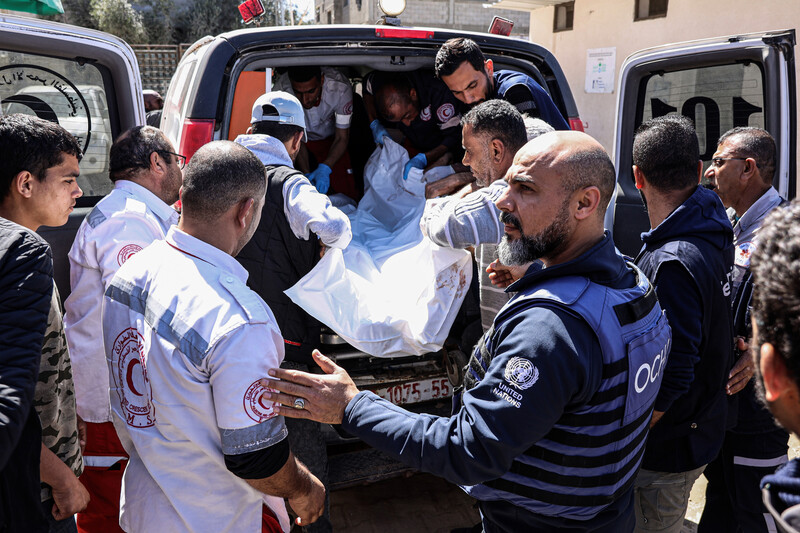
The body of an international UN staffer killed in an Israeli strike on the world body’s headquarters in Deir al-Balah, central Gaza, is transferred to Al-Aqsa Martyrs Hospital on 19 March.
APA imagesTwenty-two hospitals and five field hospitals in Gaza were partially functional and four field hospitals were fully functional, OCHA stated on 25 March. Meanwhile, “13 hospitals and five field hospitals are non-functional,” the UN office added.
The Israeli military targeted the surgical ward of Nasser Medical Complex in Khan Younis, southern Gaza, on 23 March. Two people were killed, including a member of Hamas’ political wing, and eight others were injured in the airstrike that severely damaged part of southern Gaza’s largest referral hospital.
“Hallmarks of atrocity crimes”
The following day, on 24 March, Israel killed two journalists – Al Jazeera correspondent Hossam Shabat and Palestine Today reporter Mohammad Mansour – in separate attacks.
Al Mezan, a Palestinian human rights group, said that Shabat and Mansour were “deliberately targeted” in a situation of “complete impunity” that has allowed for the killing of nearly 200 journalists since October 2023.

A child salvages an elephant plushie from the site where a tent for displaced Palestinians was hit by an Israeli airstrike in al-Mawasi, west of Khan Younis in southern Gaza, 19 March. A pregnant woman and her children were killed and other people were critically injured.
ActiveStillsThat same day, three sanitation workers were killed in an attack on a “clearly marked” sewage truck in Abasan al-Kabira, in the Khan Younis area of southern Gaza, according to OCHA.
Also on 23 March, Netanyahu’s security cabinet approved a proposal by Israel Katz, the defense minister, to set up a bureau to facilitate what it called “voluntary emigration” of Palestinians from Gaza.
On 24 March, António Guterres, the UN secretary-general, released a statement through his spokesperson declaring that he had decided to reduce the world body’s footprint in Gaza.
Guterres pointed to Israel’s blockade on the entry of humanitarian aid and the deadly Israeli strike on a UN compound on 19 March as reasons for the move.
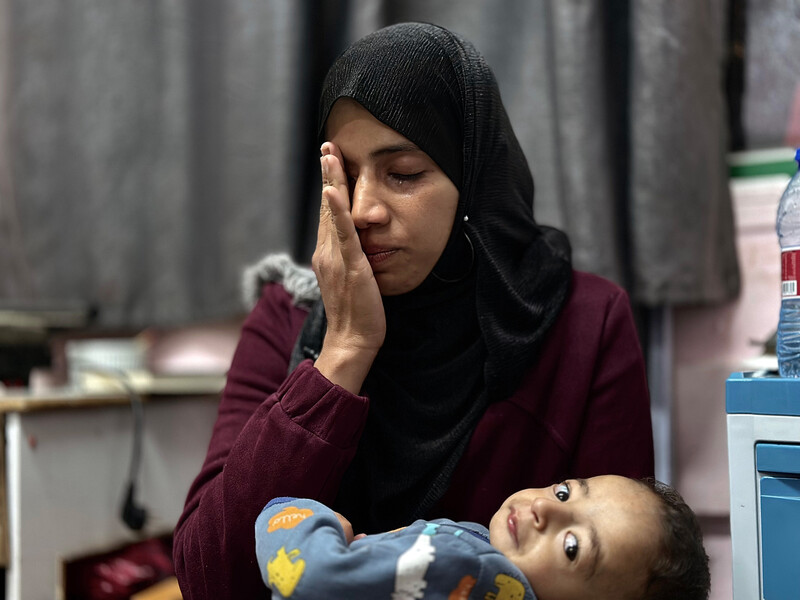
On International Mother’s Day, a woman looks after her sick child at Nasser Medical Complex in Khan Younis, 21 March.
ActiveStillsOn 27 March, Israel’s high court rejected a petition challenging the legality of Israel’s restrictions on humanitarian aid in Gaza. The petitioning organizations, all based in Israel, stated that the court ruling “reads like a hymn of praise to the state of Israel and its army during the darkest period in their history.” The groups added that it gives “a green light to continue committing war crimes and harming civilians in Gaza.”
Israel’s humanitarian aid policy is a main focus of the genocide complaint brought against the state by South Africa at the International Court of Justice and new advisory proceedings being undertaken by the court at the request of the UN General Assembly.

Children play in the burned-out auditorium of the Islamic University of Gaza in Gaza City on 21 March.
APA imagesThat same day, a worker with the US charity World Central Kitchen was killed in an Israeli strike next to a meal distribution point.
“The acts of war that we see bear the hallmarks of atrocity crimes,” Jens Laerke, spokesperson for the UN aid coordination office, OCHA, said on 28 March.
“Hundreds of children and other civilians have been killed in health and Israeli airstrikes. Intensely populated areas [and] hospitals are once again battlegrounds; patients killed in their beds, ambulances shot at and first responders killed.”
Gaza bakeries forced to close
On 30 March, which marks the Palestinian Land Day annual commemoration, Netanyahu declared his intention to “increase the pressure” and “further pound Hamas and create the optimal conditions for releasing our hostages.”
Netanyahu made clear his position that “the final stage” of a ceasefire process would see the complete surrender of Hamas and the expulsion of its leaders from Gaza.
“We will see to the general security in the Gaza Strip and will allow the realization of the Trump plan for voluntary migration,” Netanyahu stated. “This is the plan. We are not hiding this and are ready to discuss it at any time.”

Israeli occupation forces operate during a raid in Tulkarm refugee camp in the occupied West Bank, 22 March.
APA imagesPalestinians also observed the first day of Eid al-Fitr, the sacred holiday marking the end of Ramadan, on 30 March.
More than 50 Palestinians were killed and nearly 200 injured in Israeli attacks on the first day of Eid al-Fitr. On the second day of the holiday, on 31 March, Israel issued forced displacement orders covering Rafah in southern Gaza, affecting more than 140,000 people.

The bodies of members of the al-Mashharawi family are recovered from their home after it was targeted in an Israeli strike overnight in the al-Tuffah neighborhood, east of Gaza City, 22 March.
ActiveStillsOn 1 April, the World Food Program announced that all 25 of the bakeries in Gaza supported by the UN agency “have shut down due to lack of fuel and flour.”
“Hot meals are continuing, but supplies will last two weeks maximum,” the World Food Program said, adding that the agency “will distribute its last food parcels in the next two days.”
Meanwhile, according to OCHA, more than 85,000 metric tons of “food commodities, sufficient for one to two months, remain stranded outside of Gaza.”
More than 50,000 killed in Gaza
As of 31 March, the health ministry in Gaza reported 1,001 fatalities and 2,359 injuries since Israel resumed its full-scale attacks on 18 March.
More than 50,350 people in Gaza have been killed since October 2023, and another 114,400 injured, according to the ministry. Of those killed, 31 percent of them were children, 17 percent were women, 44 percent were men and 8 percent were elderly.
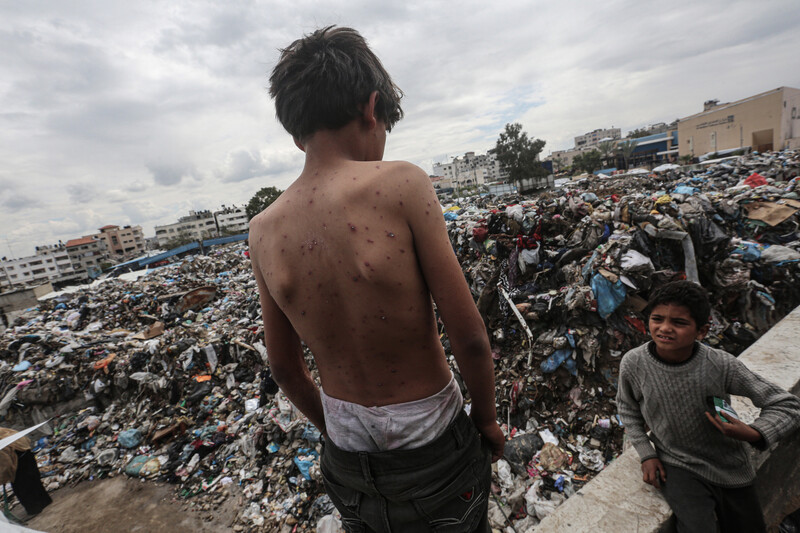
Displaced children living in a camp set up next to a landfill in the Yarmouk area of Gaza City on 22 March.
APA images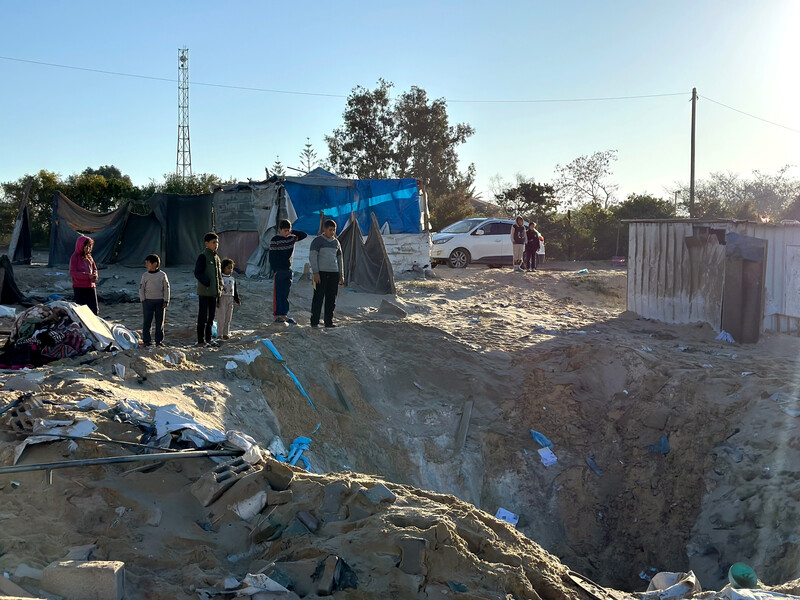
Children look at the site of an Israeli airstrike that targeted the tent of Hamas politiburo member Salah al-Bardawil and his family in Khan Younis, southern Gaza, 23 March. Several other figures in Hamas’ political wing have been targeted and killed along with members of their families since 18 March.
ActiveStillsSeven percent of Gaza’s population has either been killed or injured, according to Dr. Munir al-Bursh, the general director of the health ministry in Gaza.
“A sharp increase in trauma patients has placed Gaza’s healthcare system under immense strain,” OCHA stated, “amid an urgent need to restock trauma supplies, including fluids, antibiotics, external fixators and blood units.”
Existing supplies of anesthetics in Gaza were “insufficient to meet the growing demand, including for surgery, labor and delivery, pain management and ICU care,” OCHA added.
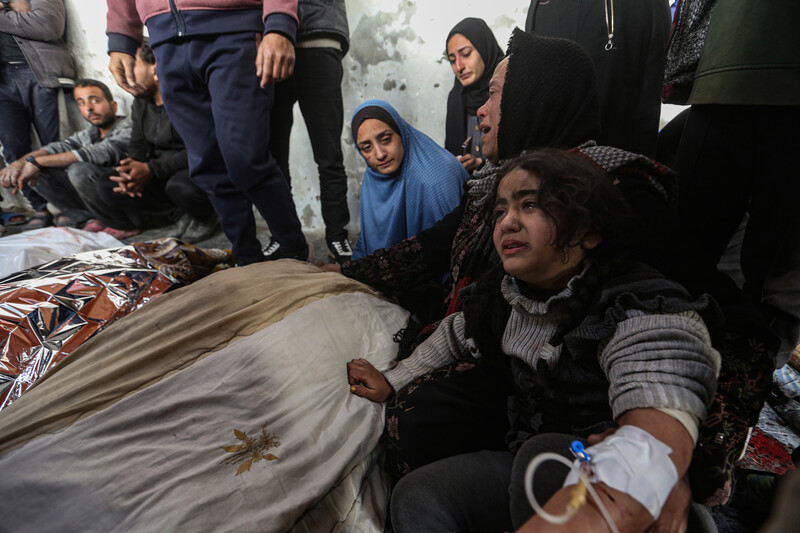
Mourners gather near the bodies of loved ones killed in Israeli strikes at Al-Ahli Arab Hospital, Gaza City, 24 March.
APA imagesIn the West Bank, 99 Palestinians had been killed by Israeli forces since the beginning of the year, including 17 children and three women, the UN office said in a report published on 27 March. More than half of those fatalities occurred “in just four localities, including Jenin and Nur Shams refugee camps,” the UN said.
West Bank fatalities
Those killed in the West Bank during March included an 18-year-old shot and killed by Israeli forces in the northern West Bank after he reportedly approached Homesh checkpoint while carrying a knife on 4 March.
That same day, according to OCHA, “Israeli forces shot and killed two Palestinians in Jenin city as part of the ongoing operations in the area.”
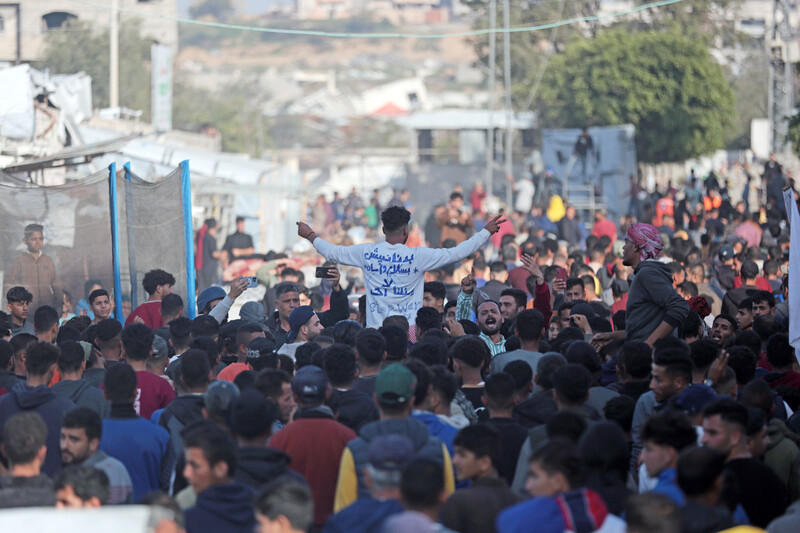
A demonstrator wears a shirt reading “We want to live in peace and safety” during a demonstration in Beit Lahiya, northern Gaza, calling for the end to the genocide, 26 March. Despite the relentless Israeli bombardment, other demonstrations took place in Jabaliya and Beit Hanoun, also located in Gaza’s north.
ActiveStillsThe UN office added: “One of those killed was reportedly trying to return home and the second was reportedly engaged in an exchange of fire with Israeli forces, who withheld his body.”
A Palestinian man riding a motorcycle was struck by soldiers driving an Israeli military vehicle in Jenin and killed on 10 March.
That same day, a 16-year-old boy was killed by Palestinian Authority forces, who had pursued the teen “pursued him in civilian vehicles, shot him in the head and chest, and arrested him,” according to OCHA.
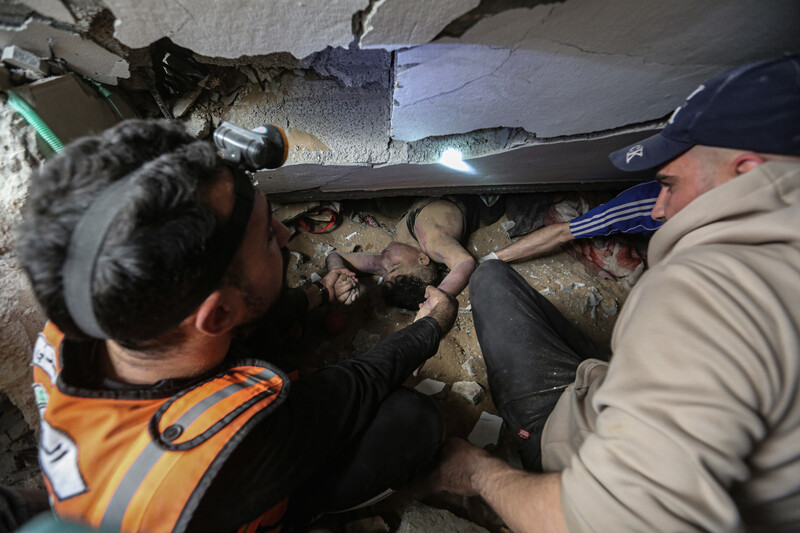
The bodies of victims are pulled from the rubble of the Awad family home following Israeli attacks in the Zeitoun neighborhood of Gaza City, 28 March.
APA images
The uniform of an Israeli soldier as settlers invade Khirbet al-Tawil, a rural community in the West Bank, on 29 March. Israeli forces ordered Palestinians to stay away from the settlers trespassing on their land and a soldier aimed his gun at an ActiveStills photographer and two solidarity activists.
ActiveStillsFour Palestinians, including a woman, were killed during an Israeli raid in Jenin lasting 10 hours on 11 March. The following day, a Palestinian man died after falling from a five-story building while fleeing Israeli forces who raided a Jerusalem building while looking for Palestinians lacking work permits.
“Recently, Israeli forces have stepped up operations in Israel to detain Palestinian workers who do not possess the required work permits, with hundreds reportedly detained,” OCHA stated.
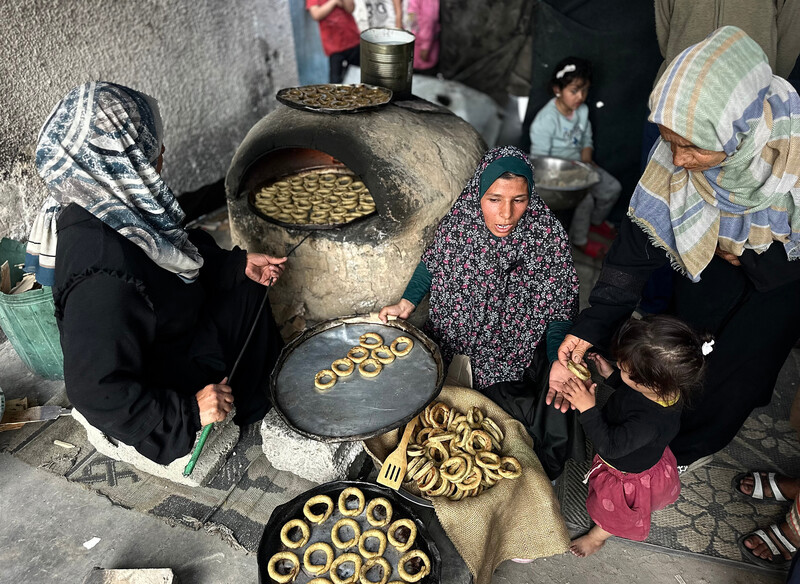
A Palestinian family prepares traditional cookies in preparation for Eid al-Fitr, the holiday marking the end of Ramadan, at an UNRWA school being used as a shelter for displaced people in Khan Younis, southern Gaza, 28 March.
APA imagesOn 14 March, according to the UN office, “Israeli forces shot and killed a Palestinian man during a raid into Salem village” in the Nablus area.
On 18 March, a Palestinian man died after he was shot by undercover Israeli forces at a café in Qalqiliya. The following day, a man was shot and killed during an Israeli raid in Ein Beit al-Mai refugee camp in the Nablus area.
The bodies of both men were withheld by Israel.
Also on 18 March, a Palestinian man died from wounds sustained during a shooting attack carried out with two others near Jerusalem that left an Israeli settler dead. Two of the three Palestinian gunmen were killed by Israeli forces at the scene and the other was in a coma and detained until 27 February, “when he was released as part of the hostage-prisoner exchange under the first phase of the Gaza ceasefire,” according to the UN.

Worshippers pray during Eid al-Fitr in Jabaliya, northern Gaza, 30 March.
APA images
Children at a school in Jabaliya refugee camp, northern Gaza, play during the Eid al-Fitr holiday, 31 March.
APA imagesOn 25 March, the Israeli military reportedly used an explosive drone inside a shop in Qalqiliya to kill a man after he refused to surrender. The following day, Israeli forces shot and killed an 18-year-old who reportedly threw stones at settlers in Beita village near Nablus. Israel has withheld the bodies of both men.
The UN added that more than 850 people were forced to leave their homes in Tulkarm in the last two weeks alone and that 431 people have been displaced by the demolition of homes on the pretext that they were built without a permit since the beginning of the year.
In a report published on 4 April, the UN office said that more than 280,000 people in Gaza had been displaced during the previous two weeks, including 100,000 people in Rafah, and that the number of aid workers killed there had risen to 409.
Jonathan Whittall, the acting head of OCHA in the West Bank and Gaza, said that “as humanitarians … we cannot accept that Palestinian civilians are dehumanized to the point of being somehow unworthy of survival … [and] people’s survival is dependent on an aid system that itself is under attack.”
Text and production by Maureen Clare Murphy.

The bodies of eight Palestine Red Crescent Society medics killed by Israeli forces after they were recovered and brought to Nasser Medical Complex in Khan Younis, 31 March. The medics were killed on 23 March while they were dispatched to the al-Hashasheen area of Rafah, southern Gaza, following Israeli bombing. Six other emergency personnel were killed and one paramedic remains missing.
ActiveStills

